I picked up this Nikkormat FTn back in the winter – it was actually the first of a string of SLRs I’ve recently either bought or tried. Beyond my usual desire to buy cameras to write about, I can’t perfectly explain my recent desire to shoot SLRs more again, though it’s definitely fair to say that the Nikkormat FTn has opened the floodgates.
For a long time, I’ve held back from SLRs by telling myself – and you lot for that matter – that I just don’t get on with the things. This was a great way to prevent myself from falling down a bit of a GAS rabbit hole… Well, what can I say, I’ve tripped and fallen down it without really realising what I was doing, and since the beginning of the year have ended up shooting quite a few more SLR cameras.
In fact, I’ve already written reviews of the Leica R6.2 and Contax RTS, both of which shall be surfacing in the next month or so. In the meanwhile though, it felt appropriate to start at the beginning with this Nikkormat FTn – an eccentric but quite fascinating camera that started this little SLR redux of mine.
The SLR Redux
Actually, SLR cameras have never entirely gone away for me. I used to have a huge Nikon collection, but at some point well-prior to starting this website I concluded that I wasn’t all that keen on being a camera “collector”, and that whilst I like owning the things, I’m not the sort to have a defined collection of one brand or one type of camera in the way proper “collectors” do. As such, the Nikon collection started to wane to the point that I just had an FM3a, F2 and F.
I’ve told the story about my discovery that my right eye was failing a few times on this website, most notably here. The shorter version is that the Nikon FM3a was, for a while at least, my dream camera – but when I bought it, I found it didn’t work for me. I couldn’t focus it with my slightly duff right eye and found left eye framing bothersome with an SLR. So I ditched it and bought a Leica M7.
But, whilst the valuable FM3a left my life, my tatty old F and F2 stayed. I don’t really use the F, but the F2 became my camera of choice for shooting my Nikon shift lens. For the 35mm PC lens, I just needed a pre-AI Nikon Mount camera with a mechanical shutter, so the F2 was perfect. It became the archetypal “shutter in a box” that people who care much less than I usually do about cameras always talk about – it was there to perform a function, and beyond that, I wasn’t that fussed about it.
Finding the Nikkormat
Then one day I happened to wander into London Camera Exchange and spotted this near-mint condition Nikkormat FTn. I actually couldn’t believe how cheap it was, especially considering its condition. But that’s the way it is – at least for now – with these older Nikon cameras. They just don’t command the cash that the later models do. In fact, there was an absolutely cracking post on this subject recently published over on EMULSIVE here – well worth a read if you’re more interested in the facts than my meandering experiences.
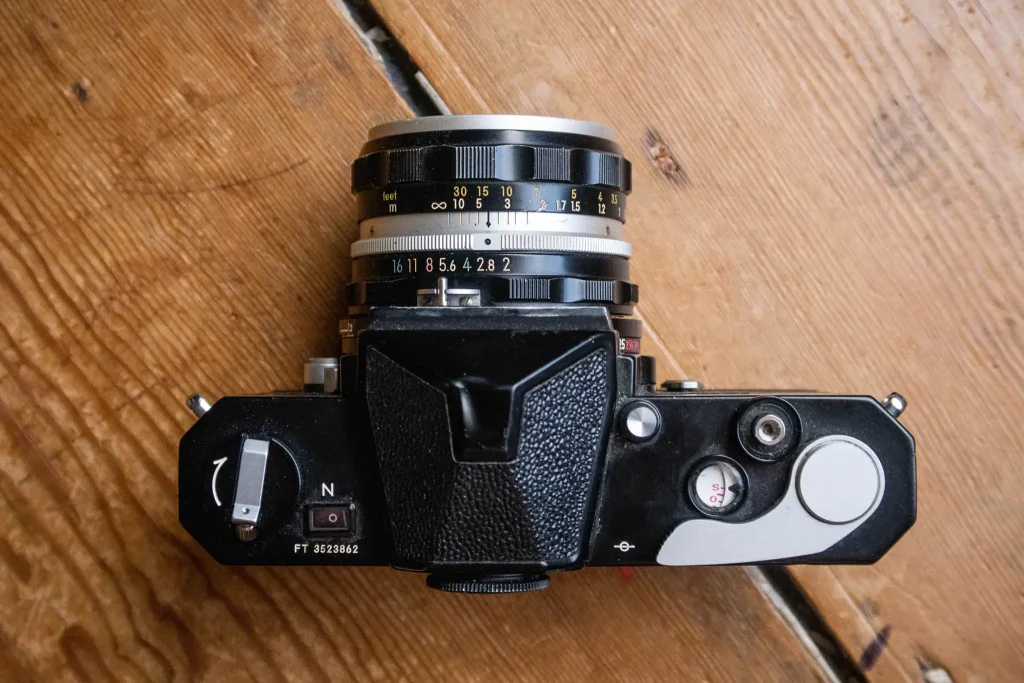
I tinkered with it for a bit in the shop, and then initially put I back on the shelf and walked away. If memory serves, it didn’t take me long to return to the shop and put my money down. It was just such a pretty looking thing that felt so good to hold and use that I couldn’t let it go. Of course, a new camera meant I also wanted a new lens, and I’d soon bought myself an old but very clean 50mm f/2.
The quirky Nikkormat FTn
As it turns out, returning to SLR shooting with a Nikkormat FTn makes for a bit of an interesting choice. These cameras are quite quirky. Mounting the lens is the first hurdle. Like the Photomic heads for the F and F2, the lenses communication with the light meter is via the “bunny ears” on the lens and a pin on the camera body/head.
Unlike with the F/F2 heads though, the pin on the FTn isn’t sprung, so the lens has to be mounted to the camera with the aperture at f5.6. Once mounted, the aperture then has to be set to its minimum, and then maximum, and then returned to the desired shooting aperture for the meter to read correctly. It’s a bit of a process, but actually, it’s quite satisfying – everything just feels mechanically true, even if it does feel a touch convoluted.
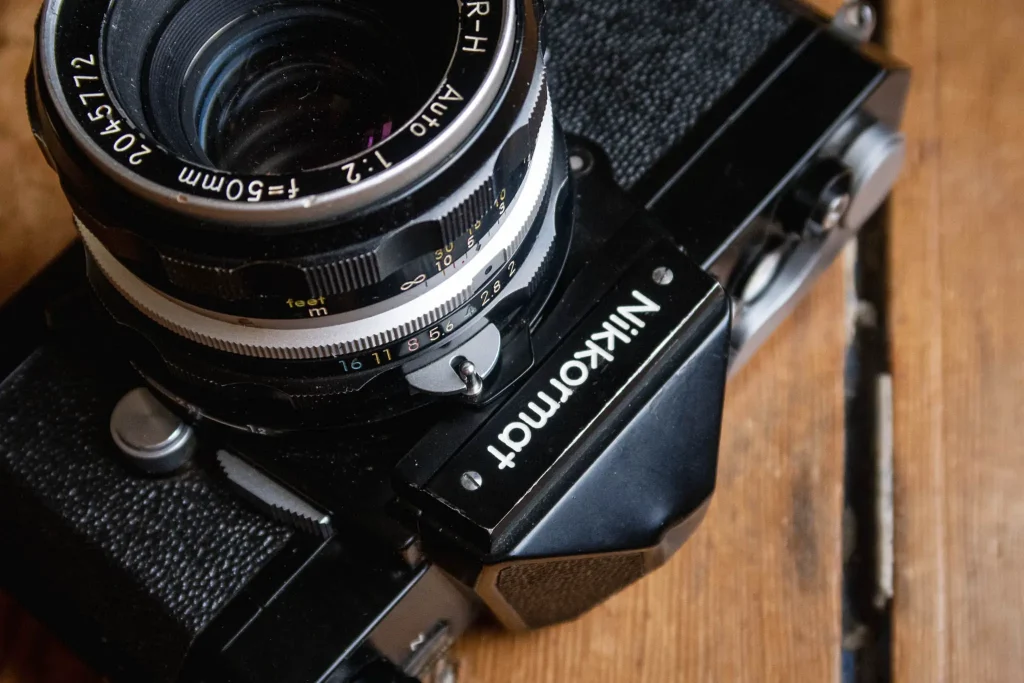
Once the lens is mounted, the second big quirk to get your head around with the Nikkormat FTN is the fact that the shutter dial is missing from the top of the camera. A little bit like the Olympus OM series cameras, it’s located around the lens mount. Unlike the OM Series cameras, it has a lever that pokes out of the left-hand side of the body of the camera.
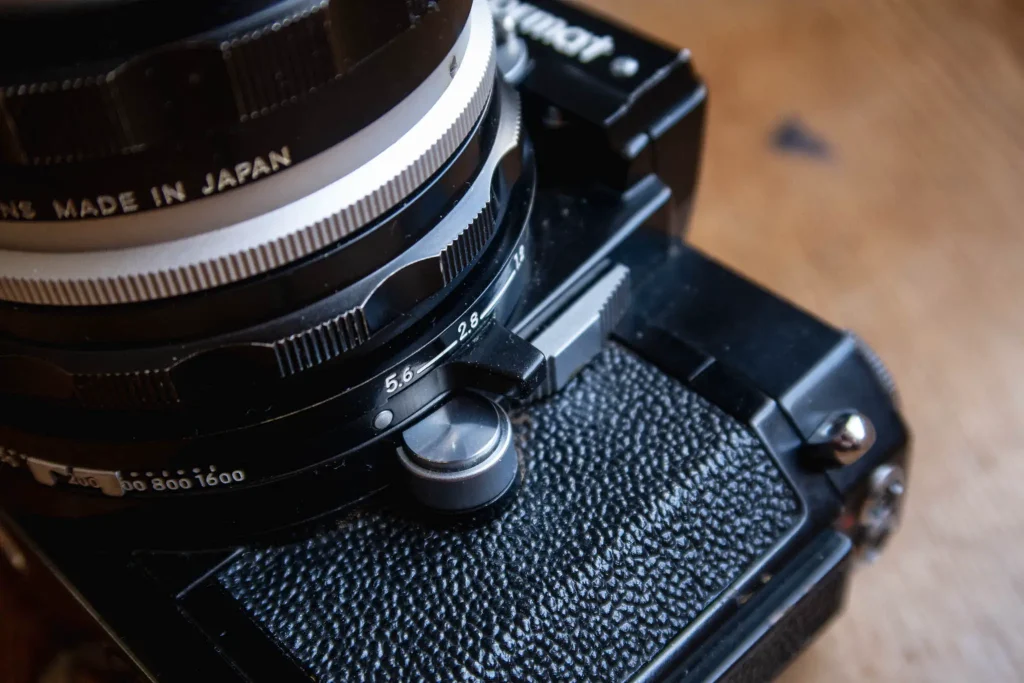
The selected shutter speed is displayed in the viewfinder, though the aperture isn’t. The result of this – at least if you use the built-in meter – is that the camera has a sort-of aperture priority feel to it. You set the aperture on the lens with the camera away from the eye, then with the camera to the eye, you can set the shutter speed so the needle in the viewfinder sits in the middle of the – and + symbols on the right-hand side of the view. Actually the meter needle in the viewfinder is another oddity – underexposure is up, and overexposure is down. You might think it would be like this due to the direction of rotation of the shutter dial, but it’s not, it’s the opposite.
The final major quirk that needs to be overcome when shooting a Nikkormat FTn is the fact that the 1.35v batteries are no longer made. I just chucked a 1.5-volt battery in and set the exposure index to 800. I tested it at home by taking a reading off a white wall in my house then compared it to another meter and found that by setting it a stop out this way, it measured fine.
The issue with modern batteries is that the voltage drops as they drain – these old cameras are sensitive to the voltage change so the meter can’t really be trusted to be perfect when using them. As such, when I went out shooting, I decided to just use the light meter on my phone. I sort of prefer shooting like this anyway, so it didn’t bother me at all.
Other features
The Nikkormat FTn is actually fairly full-featured for its age. On the left-hand side of the camera, as you hold it, there’s a lever to lock the mirror up, and there’s also a depth of field preview button on the top right-hand side of the camera. It’s the thing that looks like an awkwardly placed second shutter button. Finally there is an instant-death switch, otherwise known as a self-timer. I didn’t use any of these features mind, but they are there for folks who find them useful… Though I can’t recomend the use of self-timers on any old camera…
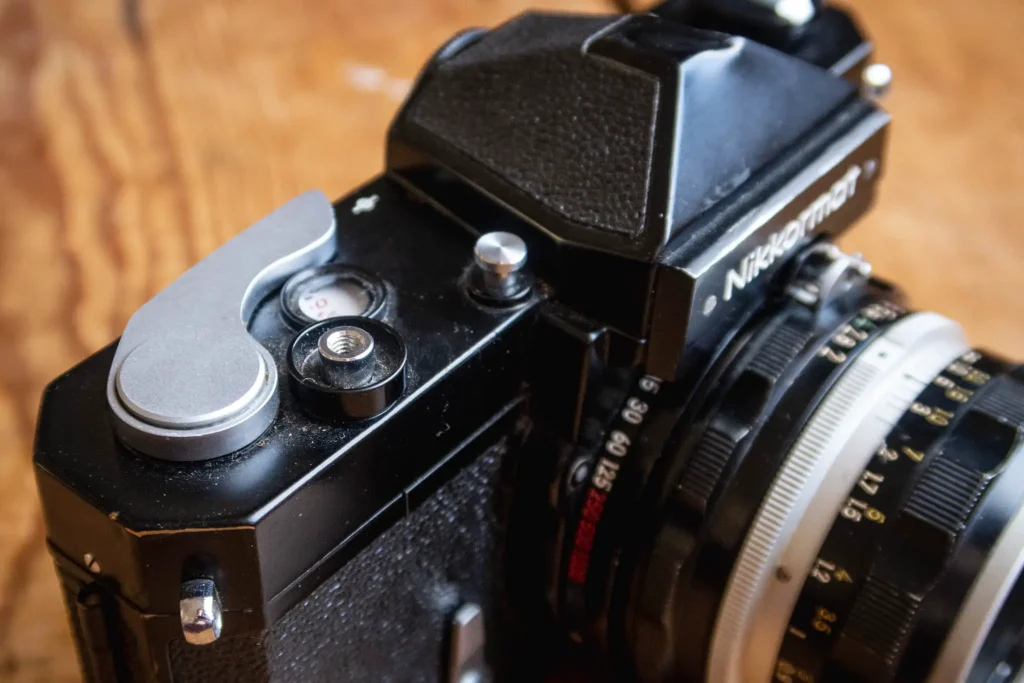
Shooting the Nikkormat FTn
My first roll with the Nikkormat FTn was way back in the winter. I didn’t have a plan with it to begin with, so chucked it in my work bag. As it turned out, this was to be a mistake – at some point, I must have bashed my bag on something and managed to dent the top of the camera. This seems to have cracked the paint on the inside of the head as the view through the finder went from perfectly clear, to slightly peppered with a few black spots of dust. It went from being near-mint to feeling more like a solid user in one foul swoop. A bit of a shame really, but these things happen…
In the end, the first shooting opportunity was on an occasion I took it out with the girls. My wife was poorly over the Christmas break and a little bit into the new year, so I’d taken them out for a walk in the woods to give her a bit of peace and quiet.
It was this experience that gave me the first hint that I might be a little bit out of practice with SLR shooting, though I did initially conclude that some of my sense of not being comfortable focusing came down to the fact I was shooting a camera with a micro-prism screen. Even in the days I did shoot SLRs, I was much more comfortable with split-screen focusing.
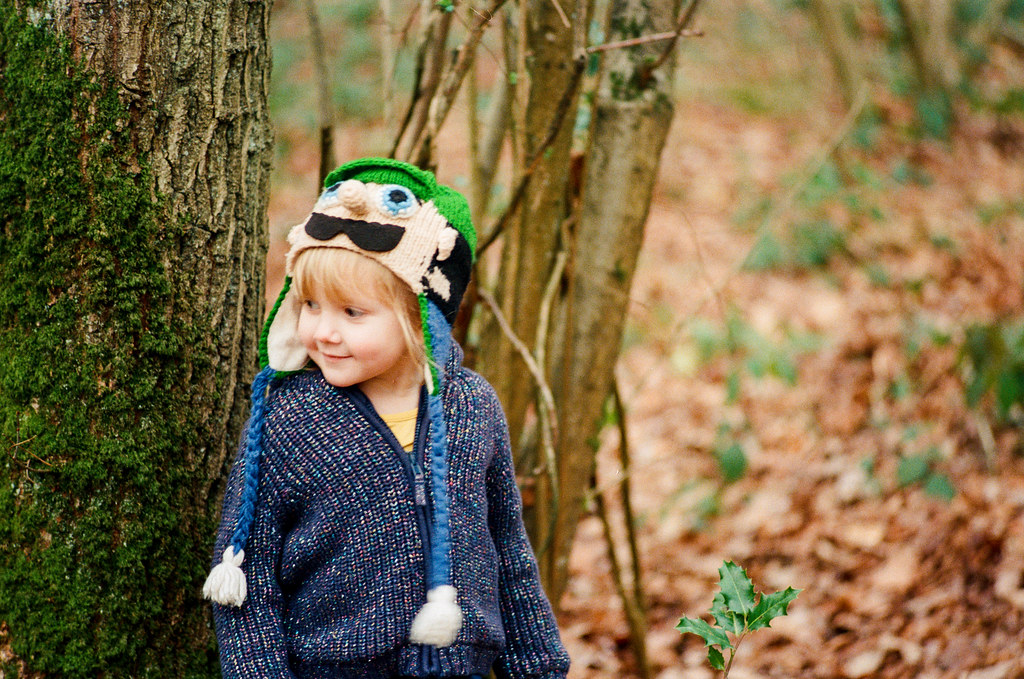
Funnily enough, I didn’t even get halfway through the roll. Norah had gotten tired whilst we were out and had decided to have a bit of a paddy. She doesn’t really like me taking her picture anyway, but when she’s tried and fed up of being out in the cold, I’m really pushing my luck.

On my return home, the camera was shelved with a little bit of a sense of having failed – I’d not shot many photos, and my confidence that they were in focus was quite low. Then, in the interim between picking it up again, I’d shot (and quite heavily ballsed up) a roll in an Olympus OM-10. This failure knocked me a little bit and had made me quite strongly come to the conclusion that the roll in the Nikkormat FTn would indeed be a failure too.
Some weeks later, I arranged to go out shooting shift lenses with Ashley Carr. I actually had that shooting day filmed, and when I have some time I’ll be writing a little more about the day to go alongside a little video of the conversations me and Ash has throughout the day. The short version though is that I’d loaned out the Nikon F2, and so had decided to shoot my 35mm PC lens on the Nikkormat FTn. Of course, when I went to load the film, I remembered I’d shot a few frames of Portra 400 with it. But since I didn’t want to shoot colour that day, I rewound it and loaded a roll of TMAX 400 instead.
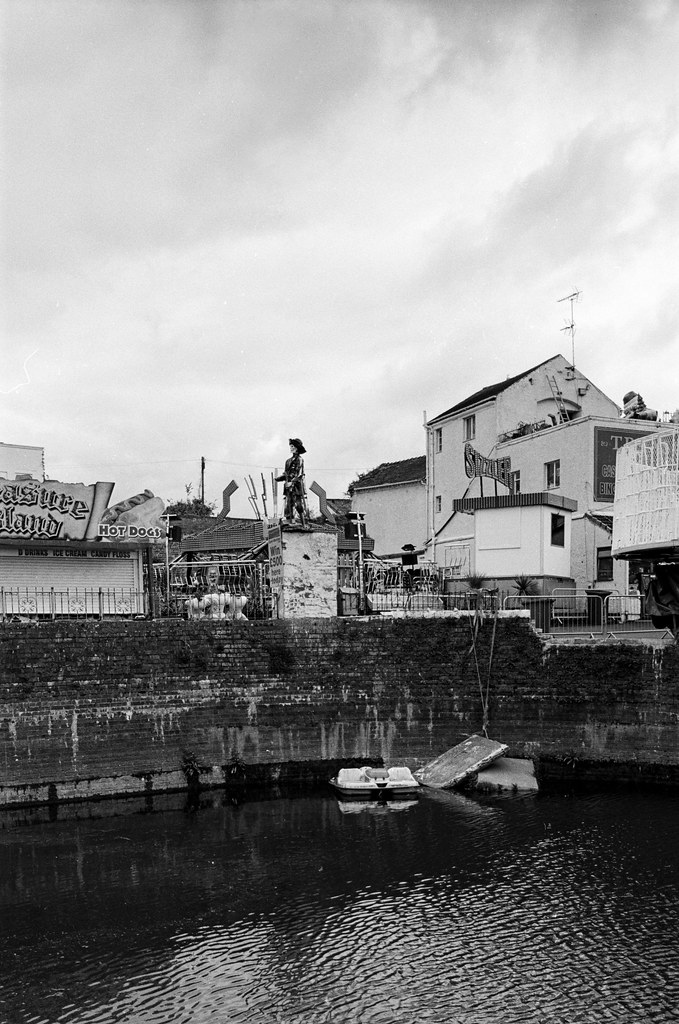
I started shooting with the shift lens in the same way as I do with the Nikon F2 – of course, there was very little difference between shooting the two cameras, at least short of the shutter dial. Then, after about 10-15 frames with the shift lens, I decided I wanted to shoot with a tighter frame and reverted to the 50mm lens. I was having to use a micro-prism screen again, but fortunately, this time, I was taking photos of static objects, so I felt a little more confident with my focusing.
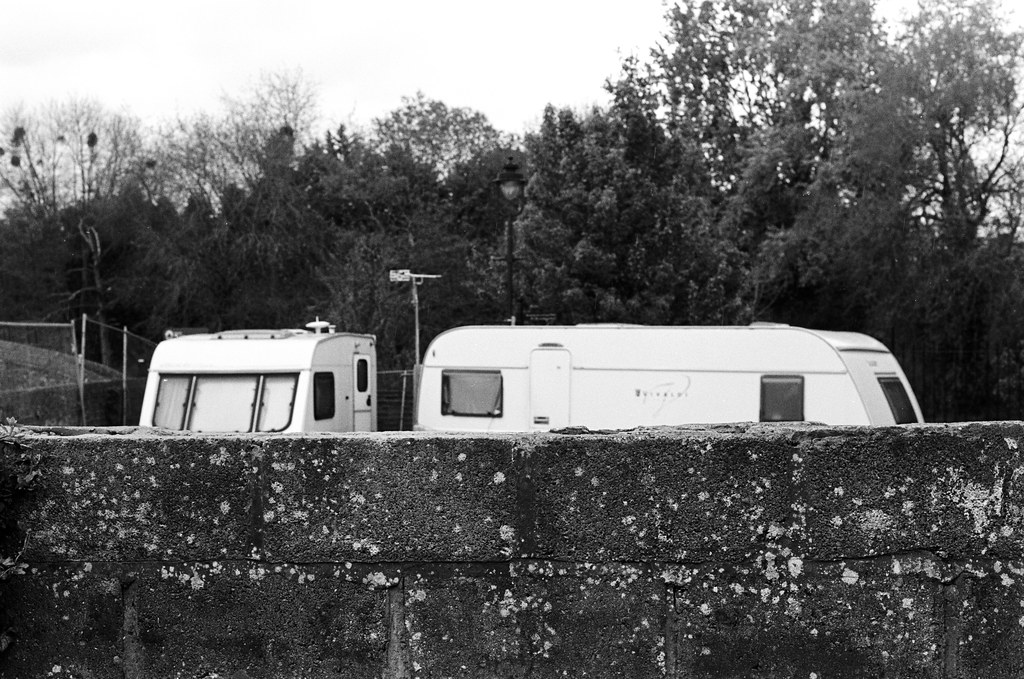
The following day I sent both rolls off for dev, and as you can see from the photos I’ve shared, I did see some success from both of them. Actually, my hit rate photographing the girls wasn’t too bad. Ironically, it was higher than with the Olympus that had given so much cause for concern. This is fairly incidental to the story of the Nikkormat FTn specifically, but this little bit of success did encourage me to pick up the aforementioned Leica R6.2 and Contax RTS.
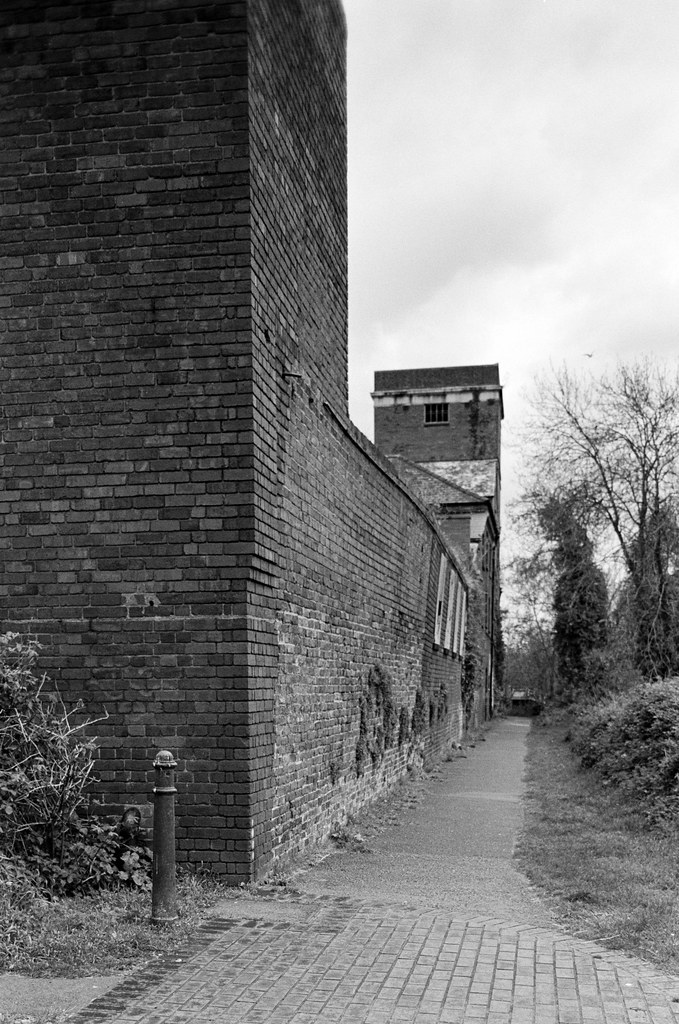
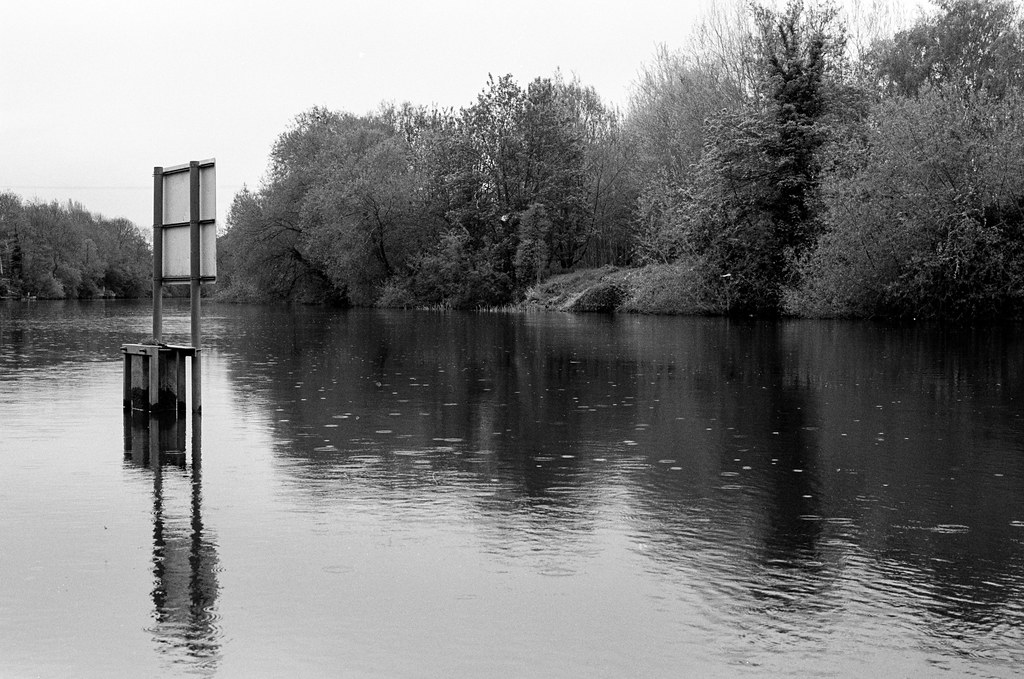
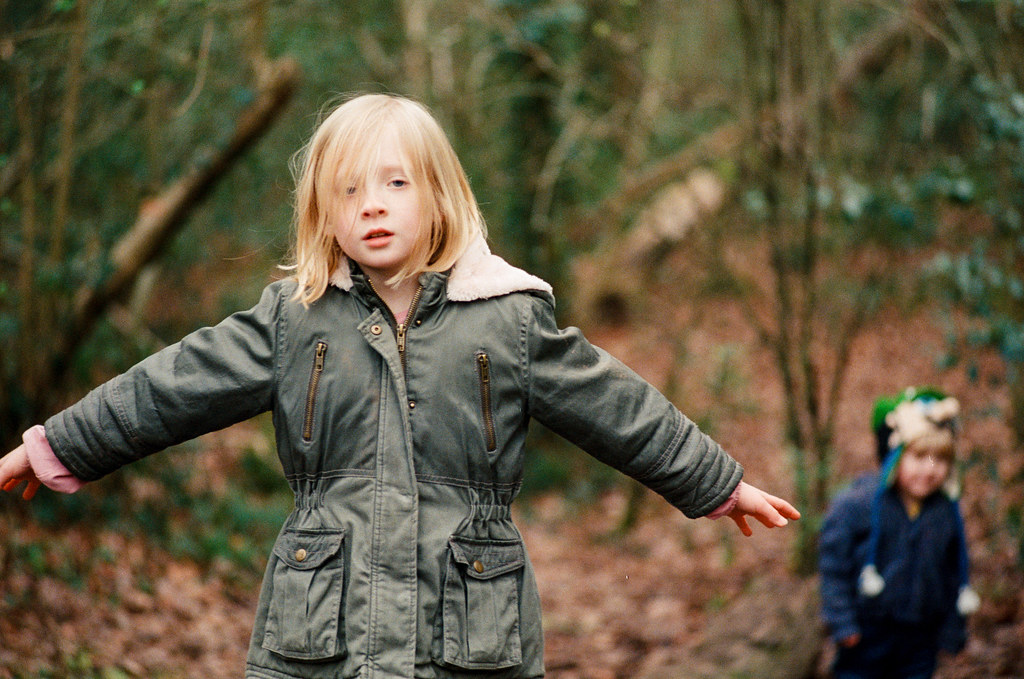
Something a little satisfying
I think it’s also worth noting that whilst I’m not entirely sure I bonded with Olympus OM-10, and despite bashing the top of it, I have felt a certain slightly inexplicable sense of satisfaction when shooting the Nikkormat FTn. This camera is not a lightweight bit of kit – but because of this, it feels every bit as solid as my Nikon F and F2. As I’ve alluded, it also feels mechanically wonderful. In fact, if you read up about these cameras online, there are plenty of reports of them being made to pretty much the same exacting standards as the Nikon pro-series cameras. I must admit, I’m also entirely suckered in by the look of the thing. The black body with the chrome accents – in my view at least – makes for a particularly aesthetically appealing bit of kit.
In fact, I mentioned this to Ash whilst we were out. Sometimes cameras just feel right, and sometimes that feeling doesn’t exactly make sense. The Nikkormat FTn is definitely from a period of camera design where SLR cameras we’re still in their infancy. The mechanical connection between the lens and camera being so visible and almost clumsy is, without doubt, a nod to that. In fact, in some ways, the need to set the aperture to f/5.6 could feel like a bit of a bodge to help save costs in the process of making a more consumer version of the pro-range F series cameras.

But somehow, despite this, and the fact that I didn’t even use the meter, the Nikkormat FTn still manages to feel quite complete to me. The slight awkwardness of the mechanics is offset entirely by how true they feel, and alongside the aforementioned satisfaction this brings in mounting an un-mounting lenses, what this camera offers in terms of features just makes it feel quite complete.
Yes, it’s quirky, it’s impossible to deny that, but if there’s something I consistently find myself drawn to, it’s cameras that feel like little could be gained by either adding or subtracting from what’s on offer. And whilst the Nikkormat FTn could in some ways be thought of as a subtraction from the pro-series cameras it was contemporary to, it doesn’t feel it at all. In fact, despite probably slightly favouring my F2 with its un-metered prism for its overall simplicity, I don’t find myself in any hurry to get it back from the person I’ve loaned it to. Instead, I’m going to enjoy the Nikkormat FTn for a little longer.
Share this post:
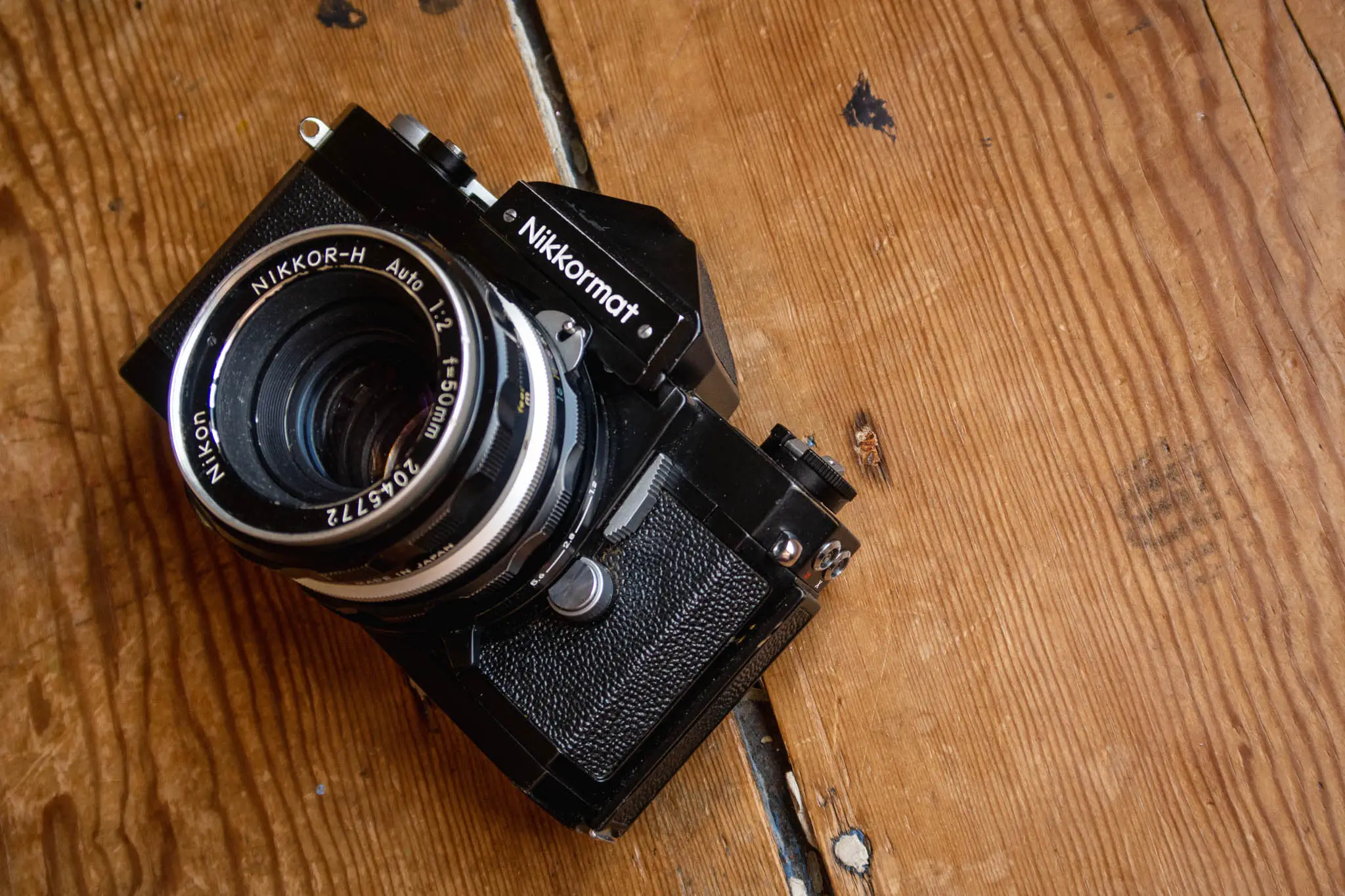








Comments
Rob on Nikkormat FTn Review – Definitely Quirky, but also a Rock Solid Camera
Comment posted: 29/07/2019
I have a FE, FTN, FG20 and EL2. I haven't tried the FE yet but will take it on vacation this year. The FG20 is just so plastic feeling. I bought it thinking it would not be so heavy, and it is light, but, man, it just doesn't feel anything like the FTN. It's a steel brick that gets great shots.
Comment posted: 29/07/2019
Tom Sheppard on Nikkormat FTn Review – Definitely Quirky, but also a Rock Solid Camera
Comment posted: 29/07/2019
I have long since come to respect the seemingly rock-like Nikomat and I now own several.
Not that long ago they could be bought in good condition for $10-$15
It is the reliability of that vertical metal bladed shutter that really appeals as well as everything else that you have mentioned Hamish.
Add a Nikkor-H 2/50 and the world is your oyster.
Great camera
Comment posted: 29/07/2019
Nigel Cliff on Nikkormat FTn Review – Definitely Quirky, but also a Rock Solid Camera
Comment posted: 29/07/2019
Comment posted: 29/07/2019
Murray on Nikkormat FTn Review – Definitely Quirky, but also a Rock Solid Camera
Comment posted: 29/07/2019
Comment posted: 29/07/2019
Comment posted: 29/07/2019
Roger B. on Nikkormat FTn Review – Definitely Quirky, but also a Rock Solid Camera
Comment posted: 29/07/2019
Stateside, clean Nikkormat and Nikomat bodes can be found on That Auction Site for $25 ... often with working light meters as well as perfectly-accurate shutters. Best of all, these gems frequently appear unused. My guess is that they were indeed bought by amateurs, who retired them to the sock drawer in favor of a newer model with auto exposure control, and teensy little fragile motors to power auto focus, and film advance. Those cameras today are mostly junkers. But the Nikkormats soldier on, happy to be mated with bargain legacy pre-AI glass. Maybe guys like you and I should not tell everyone this secret, or prices will begin to rise!
Comment posted: 29/07/2019
Nick Lyle on Nikkormat FTn Review – Definitely Quirky, but also a Rock Solid Camera
Comment posted: 29/07/2019
Comment posted: 29/07/2019
Lee on Nikkormat FTn Review – Definitely Quirky, but also a Rock Solid Camera
Comment posted: 29/07/2019
Mine came with a later model 50mm f/2 pre-AI lens for about $65 USD total. I have since purchased a Nikkor-P Auto 105mm f/2.5 lens as well and love the combo. One nice benefit to using these Nikkormats is that they are fully forward compatible with Nikon AI and AI-S lenses with the rabbit ears. You can also mount other Nikon lenses with manual aperture rings, like Nikon Series E or D-series autofocus lenses and still meter with them despite not having the rabbit ears because the conveniently placed stop-down button allows seamless stop-down metering. All in all, the Nikkormat series has a lot going for it, the cameras are built like tanks, and they are a tremendous value.
Comment posted: 29/07/2019
Comment posted: 29/07/2019
Comment posted: 29/07/2019
Comment posted: 29/07/2019
Comment posted: 29/07/2019
Comment posted: 29/07/2019
Scott on Nikkormat FTn Review – Definitely Quirky, but also a Rock Solid Camera
Comment posted: 29/07/2019
The Nikkormat FtN was my first ever real camera. I vaguely remember it cost a little over $200 with f f2 lens, a whole summer's work. I kept it for at least ten years, subjected it to every kind of indignity, and it never faltered. It took the first pictures I ever sold and made back its cost a dozen times.
The 50mm f2 is a much ignored but really fine lens.
I kind of liked the odd shutter speed control, maybe because I had nothing to compare it to, but your left hand is already in place to change it and you don't have to move at all. You'll often read people hating on it, but I think that's because they've gotten used to the dial on top and it's just something new to them.
It has all the delicacy of a metal brick, but you never need to be afraid you'll break it.
Thanks for this.
Comment posted: 29/07/2019
Comment posted: 29/07/2019
Comment posted: 29/07/2019
P Laskey on Nikkormat FTn Review – Definitely Quirky, but also a Rock Solid Camera
Comment posted: 29/07/2019
The pin and claw connection requiring the lens to be set to f5.6 before mounting was also used on the Nikon F and early F2 photomic prisms.
Comment posted: 29/07/2019
Stephen on Nikkormat FTn Review – Definitely Quirky, but also a Rock Solid Camera
Comment posted: 29/07/2019
Comment posted: 29/07/2019
Bill Smith on Nikkormat FTn Review – Definitely Quirky, but also a Rock Solid Camera
Comment posted: 29/07/2019
Graham Line on Nikkormat FTn Review – Definitely Quirky, but also a Rock Solid Camera
Comment posted: 30/07/2019
Kodachromeguy on Nikkormat FTn Review – Definitely Quirky, but also a Rock Solid Camera
Comment posted: 30/07/2019
Terry B on Nikkormat FTn Review – Definitely Quirky, but also a Rock Solid Camera
Comment posted: 30/07/2019
I'd always wondered about the Nikkormats, but never enough to try one out in the shop as I'd mistakenly assumed that they were automatics! What, me, use an automatic camera?
Anyway, I digress. For about the last 6 to 7 years I have been trying to re-acquire an example of every camera that I've owned going back to 1960. About 3 years ago I got an excellent black Photomic FTn with working meter and the period f1.4/50. Looking for the 43-86 zoom I checked out Japanese sellers on ebay and came across an example being sold as mint at what I thought was a silly (low) price. He was also listing a number of Nikomat (sic) FTn bodies at a low price and one of which seemed in VG condition, save a little ding on the top of the prism housing, and fully working. His postal rates were in the lower range and I could get both for the same charge. So I pressed the BIN button. The zoom turned out to be in mint condition, in fact it looked unused and the Nikomat was in a condition more than acceptable for my purpose.
Being familiar with the F, I was somewhat surprised at the weight of the Nikomat, nothing to suggest build quality had been compromised. TTL metering via swing pointer, clear v/f were all that I'd have needed. But, handling it today, I'm sure that having the shutter speeds around the lens throat would have put me off it back then. The "rabbit ears" still have to engage a pin for metering, although with a Photomic head it is a little easier to confirm correct engagement. However, it is easy even today, to see why this would have been a popular camera. Nikon quality, but not cheapened to meet a price point.
Comment posted: 30/07/2019
Ashley Carr on Nikkormat FTn Review – Definitely Quirky, but also a Rock Solid Camera
Comment posted: 30/07/2019
Another fan here of the Nikkormat range. I have a FT2 and I recently picked up a Nikkormat EL with a Nikkor H auto 50/2. Bought the camera as it came with the Nikon AR-1 soft release attached. Altogether it came to less than what I could buy the Shiites release on its own for (as that’s what I wanted).
So now I’ve got two Nikkor H auto 50’s and I love them. Being single coated I love what they do with black and white film and the low contrast look that comes from single coated glass. I’m sending one off to be AI converted so I can use it on my Digital Nikon work camera.
Even though when I need an SLR (mostly for shift lenses like you) I’ll reach for the F2 or F3 as the 100% viewfinders come in incredibly useful but i’ll still take the FT2 out for a spin once in a while.
Comment posted: 30/07/2019
Huss on Nikkormat FTn Review – Definitely Quirky, but also a Rock Solid Camera
Comment posted: 31/07/2019
Seriously, the dual meter read out is a sweet touch. How many other kameras have that? And like some others, I prefer the FT2 and it works with AI/AI-S lenses as well as non AI. And uses modern 1.5 v cells (one).
p.s. my favourite lens on the Nikkormat is the Nikkor GN 45mm 2.8. Super compact pancakey style, lovely rendering (even though I'm not sure what that means but everyone seems to say it. Along with something about micro contrast..)
Comment posted: 31/07/2019
Nick Lyle on Nikkormat FTn Review – Definitely Quirky, but also a Rock Solid Camera
Comment posted: 08/09/2019
Comment posted: 08/09/2019
Spencer on Nikkormat FTn Review – Definitely Quirky, but also a Rock Solid Camera
Comment posted: 20/06/2020
Comment posted: 20/06/2020
Kent Teffeteller on Nikkormat FTn Review – Definitely Quirky, but also a Rock Solid Camera
Comment posted: 05/11/2020
I can say I've shot pictures with both the Canon FTb and the Nikkormat FTN (P.S. the Canon is my favorite Canon SLR ever, my first SLR). Both in excellent condition operating well, take superb pictures. Both are reliable, faithful tools I have full confidence in to be an extension of Kent. I took my Nikkormat FTN (recent $60 nice find with Nikkor 50 1.4 and case) to the Cherohala Skyway in Tellico Plains, Tennessee. I ran 2 rolls of film through it, and used my Gossen Pilot 2 light meter. The only film photographer around 4 DSLR shooters, took pictures of Bald River Falls and Baby Falls. The camera handled superbly, and never made me feel nervous in any way.
Chris on Nikkormat FTn Review – Definitely Quirky, but also a Rock Solid Camera
Comment posted: 29/06/2021
Toby Madrigal on Nikkormat FTn Review – Definitely Quirky, but also a Rock Solid Camera
Comment posted: 23/10/2021
Michael S. Goldfarb on Nikkormat FTn Review – Definitely Quirky, but also a Rock Solid Camera
Comment posted: 02/01/2022
My parents were pros who'd started a commercial studio right after WWII. When my memories kick in in the early sixties, everything "important" was being shot on 4x5 (Graphic View II) or 120 (original Mamiyaflex, then upgraded to a C330). We got our first SLR, a Nikkorex F, in 1963, with a 50/2 and the soft-at-all-focal-lengths 43-86 zoom, but we only used it for vacation slides. Within a couple of years, we were impressed enough with the Nikkorex results to acquire a Nikkormat FT and more lenses (50/1.4, 105/2.5, 28/3.5). Soon after, we got a Nikkormat FTn and an F Photomic (eventually replaced by a pair of F2 Photomics), and even more lenses. But I always enjoyed using the Nikkormat more than the Nikons: the same lenses and meter, but in a more streamlined, lighter body.
And let me be clear as someone who was there working among pros and reading all the photo magazines at the time: the Nikkormat was BELOVED by news and documentary photographers for the exact same reason. It was NOT looked down upon as an amateur camera: yeah, it was simplified compared to the F, but just as rugged, and it cost significantly less. There are loads of images of photojournalists covering the Vietnam war with both a Nikon F and a Nikkormat around their necks!
Before I continue, let me observe how weird it is to me to see today's "analog" folk describing the Nikon rabbit-ears physical method of telling the meter where the aperture is set, and the "Nikon shuffle" required to tell it the widest f-stop, being described as primitive and awkward. This was the height of sophistication at the time! I guess a lot of you just cannot imagine a world where 99% of everything was manual and mechanical, not electronic and automatic, much less "smart". Yeah, it was quite different.
Cut to a decade ago. My parents are gone, and we've dismantled their 50-year-plus photo studio while preparing to sell their house, and whatever equipment we didn't sell, give away, or trash remained with me. Two F2s and a broken Nikkormat, plus seven lenses and other Nikon accessories (close-up filters, bellows, focusing screens, eyepiece diopters, proprietary cable release, etc.) We'd had the broken Nikkormat - plus the long-broken 43-86 - placed alongside him in our dad's coffin when he died: it seemed appropriate for a lifelong photographer...
And over the last decade, I've been using the F2s regularly, mostly with the incredibly small/light and SHARP 45/2.8 GN lens, sometimes with the DP-1 meter head, sometimes with a plain prism and a meter, or just estimating exposure: hey, I'm using Tri-X. I've shot at times with the other lenses too, especially the 35/2 and stunning 105/2.5.
During the summer, I picked up a nonworking Nikkormat FTn at a flea market and was reminded how much I preferred the Nikkormat to the Nikons, and since one of my F2s now has a seized-up shutter/advance (requiring an expensive repair I can't really justify), I started looking for a Nikkormat to be a "backup body". Well, the one I found works great, and after putting a test roll through and getting fine results... I've put the F2 away as the backup body and intend to mainly use the Nikkormat... again!
Mike Sutton on Nikkormat FTn Review – Definitely Quirky, but also a Rock Solid Camera
Comment posted: 06/01/2022
David Murray on Nikkormat FTn Review – Definitely Quirky, but also a Rock Solid Camera
Comment posted: 19/04/2023
One of the reasons why the Leicaflex was derided upon its release. Also, please bear in mind that, upon release in 1959, the Nikon F had lenses from 21-800mm. The Leicaflex had four lenses a 35mm f2.8, 50mm f2, 90mm f2.8, 135mm f2.8. These, as many have noted, correspond to the frames in the viewfinder’s of the M2 and M3, later (1967) with the finders of the M4. But, like the Nikkormat, the Leicaflex trio were very well built. I have owned a Nikkormat, and now have a Leicaflex (original 1964 model) and really enjoy the substantial quality of build. These are cameras to depend on. Yes, there’s a problem with dud meters or non-availability of the mercury batteries. So what? Estimate, use a handheld meter even some app on a mobile phone. I have 60 years experience.
But these cameras last, be it Nikkormat or Leicaflex trio or Minolta SRT or Pentax screw.
I read somewhere that film is coming back. Well there’s plenty of film cameras out there waiting to be used. Thank you Hamish for reviewing them. Perhaps someone will lend you a Leicaflex to review? The SL (selective light) was made 1968-1974 and the longest production run so there’s plenty out there.
Steve Kotajarvi on Nikkormat FTn Review – Definitely Quirky, but also a Rock Solid Camera
Comment posted: 11/12/2023